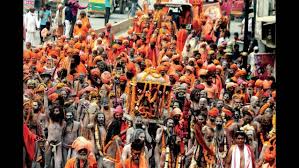The Juna Akhara of Varanasi has revived its ancient and revered tradition by organizing a grand and elaborate procession following the Prayagraj Maha Kumbh. After completing the sacred bathing rituals at the holy confluence, the Akhara makes its way back to Varanasi, where it conducts an impressive procession to ceremoniously install the deity at the primary Akhara center. This event attracts a massive gathering of devotees from all over India and beyond, as they come together to witness and participate in this age-old tradition.
Mahant Prem Giri, the International President of Juna Akhara, elaborated on the historical and spiritual significance of this practice. He explained that while the deities worshipped during the Ujjain and Nashik Kumbh Melas are different, the deities of ‘Kashi-Prayagraj’ hold a special place in the Juna Akhara tradition. These deities, which are taken on a grand procession after every Kumbh and Ardh Kumbh, remain at the heart of this long-standing religious custom that has been meticulously followed for generations.
In an exclusive conversation with ETV Bharat, Mahant Prem Giri further expounded upon the tradition, emphasizing the deep-rooted connection between Lord Shiva and the Juna Akhara. According to him, this custom involves bringing Lord Shiva, who is the principal deity of the Akhara, back to the main office in Varanasi. The grand procession that follows is a spectacular event where saints and sadhus, including the revered Naga Sadhus, march in unison through the city streets, accompanied by musical bands and devotional chants. This visually mesmerizing parade culminates in the ceremonial installation of the deity at the Akhara’s main center in Varanasi, reinforcing the religious and cultural heritage associated with the tradition.
Juna Akhara is not just one of the 13 Akharas participating in the Kumbh, Ardh Kumbh, and Maha Kumbh festivities, but it is also the largest and most prominent among them. The head office of Juna Akhara is situated at the sacred Hanuman Ghat in Varanasi. This location holds immense significance as it serves as the venue for key organizational proceedings, including the crucial election process for selecting individuals to hold prominent leadership positions within the Akhara, such as the president and other administrative authorities. The return of the deity to Varanasi is not just a momentous event but is also observed with various intricate rituals, including prayers, recitations of holy scriptures, and offerings that enhance the spiritual aura of the occasion.
Mahant Prem Giri further shared that after the deity is reinstalled at the Akhara in Varanasi, it will remain there for six years before it is taken back to Prayagraj in preparation for the next Kumbh Mela in 2031. He explained that different deities are specifically invoked for the Kumbh Melas held at different locations, and the deity from Varanasi is uniquely designated to participate solely in the Prayagraj Kumbh. This intricate system of worship and deity veneration adds to the sanctity of the event, making it a deeply cherished practice among devotees and followers of the Akhara tradition.
The grand procession and the subsequent rituals mark a significant cultural and spiritual event, reinforcing the importance of devotion, discipline, and continuity in religious traditions. By upholding and reviving this centuries-old practice, the Juna Akhara continues to preserve and celebrate the rich legacy of Hindu spirituality and faith, ensuring that future generations remain connected to these sacred customs.

